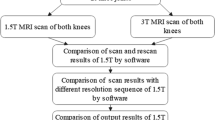Abstract
This study was aimed to investigate the accuracy and time saving of MRI Argus application in the assessment of cartilage volume in osteoarthritic knees. Twelve knees of patients suffering from osteoarthritis were scanned with a 1.5 T MRI using a 3D gradient echo sequence with selective water excitation. Cartilage volume of the tibial and patellar compartment was determined with a validated multiprocessing computer system (Octane Duo, Silicon Graphics, Mountain View, Calif., USA). The calculated cartilage volumes were compared to the results acquired by the Argus (Siemens Inc., Erlangen, Germany) application software using the MRI data sets. Compared to the multiprocessing computer system a time saving of at least 30 min for cartilage volume determination was achieved. The mean differences of Argus versus the multiprocessing computer system were 4.26±0.84 and 7.80±0.87% for the medial and lateral tibial plateau and 5.94±0.59% for the patella (no statistical significant difference; P>0.05). The applied Argus software can be used for fast and accurate determination of cartilage volume in the knee joint.
Similar content being viewed by others
References
Felson DT, Naimark A, Anderson J, Kazis L, Castelli W, Meenan RF (1987) The prevalence of knee osteoarthritis in the elderly. The Framingham Osteoarthritis Study. Arthr Rheum 30:914–918
Preidler KW, Resnick D (1996) Imaging of osteoarthritis. Radiol Clin N Am 34:259–271
Ayral X, Gueguen A, Ike RW, Bonvarlet JP, Frizziero L, Kalunian K, Moreland LW, Myers S, O’Rourke KS, Roos H, Altman R, Dougados M (1998) Inter-observer reliability of the arthroscopic quantification of chondropathy of the knee. Osteoarthr Cartil 6:160–166
Peterfy CG (2002) Imaging of the disease process. Curr Opin Rheumatol 14:590–596
Disler DG (1997) Fat-suppressed three-dimensional spoiled gradient-recalled MR imaging: assessment of articular and physeal hyaline cartilage. Am J Roentgenol 169:1117–1123
Disler DG, McCauley TR (1998) Clinical magnetic resonance imaging of articular cartilage. Top Magn Reson Imaging 9:360–376
Kawahara Y, Uetani M, Nakahara N, Doiguchi Y, Nishiguchi M, Futagawa S, Kinoshita Y, Hayashi K (1998) Fast spin-echo MR of the articular cartilage in the osteoarthrotic knee. Correlation of MR and arthroscopic findings. Acta Radiol 39:120–125
Roemer FW, Guermazi A, Lynch JA, Peterfy CG, Nevitt MC, Webb N, Li J, Mohr A, Genant HK, Felson DT (2005) Short tau inversion recovery and proton density-weighted fat suppressed sequences for the evaluation of osteoarthritis of the knee with a 1.0 T dedicated extremity MRI: development of a time-efficient sequence protocol. Eur Radiol DOI 10.1007/s00330-004-2608-6
Libicher M, Ivancic M, Hoffmann V, Wenz W (2005) Early changes in experimental osteoarthritis using the Pond–Nuki dog model: technical procedure and initial results of in vivo MR imaging. Eur Radiol 15:390–394
Vande Berg BC, Lecouvet FE, Maldague B, Malghem J (2004) MR appearance of cartilage defects of the knee: preliminary results of a spiral CT arthrography-guided analysis. Eur Radiol 14:208–214
Guermazi A, Zaim S, Taouli B, Miaux Y, Peterfy CG, Genant HG (2003) MR findings in knee osteoarthritis. Eur Radiol 13:1370–1386
Graichen H, von Eisenhart-Rothe R, Vogl T, Englmeier KH, Eckstein F (2004) Quantitative assessment of cartilage status in osteoarthritis by quantitative magnetic resonance imaging: technical validation for use in analysis of cartilage volume and further morphologic parameters. Arthr Rheum 50:811–816
Burgkart R, Glaser C, Hyhlik-Durr A, Englmeier KH, Reiser M, Eckstein F (2001) Magnetic resonance imaging-based assessment of cartilage loss in severe osteoarthritis: accuracy, precision, and diagnostic value. Arthr Rheum 44:2072–2077
Eckstein F, Reiser M, Englmeier KH, Putz R (2001) In vivo morphometry and functional analysis of human articular cartilage with quantitative magnetic resonance imaging—from image to data, from data to theory. Anat Embryol (Berl) 203:147–173
Piplani MA, Disler DG, McCauley TR, Holmes TJ, Cousins JP (1996) Articular cartilage volume in the knee: semiautomated determination from three-dimensional reformations of MR images. Radiology 198:855–859
Eckstein F, Westhoff J, Sittek H, Maag KP, Haubner M, Faber S, Englmeier KH, Reiser M (1998) In vivo reproducibility of three-dimensional cartilage volume and thickness measurements with MR imaging. Am J Roentgenol 170:593–597
Cohen ZA, McCarthy DM, Kwak SD, Legrand P, Fogarasi F, Ciaccio EJ, Ateshian GA (1999) Knee cartilage topography, thickness, and contact areas from MRI: in-vitro calibration and in-vivo measurements. Osteoarthr Cartil 7:95–109
Mohr A, Priebe M, Taouli B, Grimm J, Heller M, Brossmann J (2003) Selective water excitation for faster MR imaging of articular cartilage defects: initial clinical results. Eur Radiol 13:686–689
Stammberger T, Eckstein F, Michaelis M, Englmeier KH, Reiser M (1999) Interobserver reproducibility of quantitative cartilage measurements: comparison of B-spline snakes and manual segmentation. Magn Reson Imaging 17:1033–1042
Graichen H, Springer V, Flaman T, Stammberger T, Glaser C, Englmeier KH, Reiser M, Eckstein F (2000) Validation of high-resolution water-excitation magnetic resonance imaging for quantitative assessment of thin cartilage layers. Osteoarthr Cartil 8:106–114
Kshirsagar AA, Watson PJ, Tyler JA, Hall LD (1998) Measurement of localized cartilage volume and thickness of human knee joints by computer analysis of three-dimensional magnetic resonance images. Invest Radiol 33:289–299
Cicuttini FM, Wluka AE, Forbes A, Wolfe R (2003) Comparison of tibial cartilage volume and radiologic grade of the tibiofemoral joint. Arthr Rheum 48:682–688
Uebelhart D, Malaise M, Marcolongo R, DeVathaire F, Piperno M, Mailleux E, Fioravanti A, Matoso L, Vignon E (2004) Intermittent treatment of knee osteoarthritis with oral chondroitin sulfate: a one-year, randomized, double-blind, multicenter study versus placebo. Osteoarthr Cartil 12:269–276
Author information
Authors and Affiliations
Corresponding author
Additional information
The authors certify that there is no actual or potential conflict of interest in relation to this article
Rights and permissions
About this article
Cite this article
Maataoui, A., Graichen, H., Abolmaali, N.D. et al. Quantitative cartilage volume measurement using MRI: comparison of different evaluation techniques. Eur Radiol 15, 1550–1554 (2005). https://doi.org/10.1007/s00330-005-2744-7
Received:
Revised:
Accepted:
Published:
Issue Date:
DOI: https://doi.org/10.1007/s00330-005-2744-7




